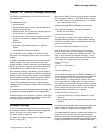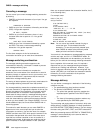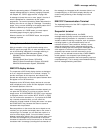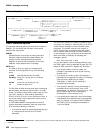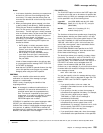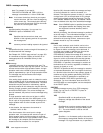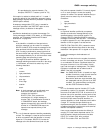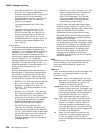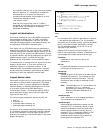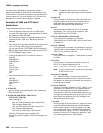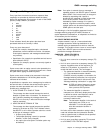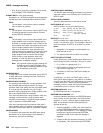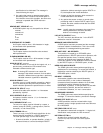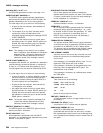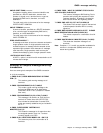CMSG—message switching
If you specify ROUTE=(.L1,.L2), all entries from
DFHTLTL1 are included as destinations.
Duplicate entries within DFHTLTL1 are kept. All
entries from DFHTLTL2 are checked for
duplicates against the entries in the previously
specified DFHTLTL1 and, if a duplicate is
found, it is not repeated.
The resulting destination list is T001, T001,
T001/OP1.
The order in which you specify the TLTs is
significant. If you specify R=(.L2,.L1), the
DFHTLTL2 entries T001 and T001/OP1 are
included in the destination list. However, the
two entries for T001 in DFHTLTL1 are not
included because T001 is already in DFHTLT2.
In this case, the resulting destination list is
T001, T001/OP1.
(±
termid/opid,...
)
A +termid/opid adds the specified destination (if not
a duplicate) to the destinations contained in the
requested TLT. A −termid/opid deletes the specified
destination from the requested TLT. A −termid,
without an opid, deletes all destinations of that
terminal (with or without operator identifier) resulting
from the requested TLT. + or −termid/opid
parameters affect only those entries that result from
requested TLTs, and have no effect on other + or −
termid/opid parameters in the same request. All TLT
suffixes must be entered before any + or −
parameters.
Here are some examples that show the effects of
specifying both TLTs that contain duplicate entries
and ± entries. For these examples, assume that
terminal list table DFHTLTL1 contains T001 twice,
and that DFHTLTL2 contains T001 and T001/OP1.
ROUTE=(.L1,.L2,+T001) has the same effect as
R=(.L1,.L2). The entry +T001 is not added,
because it is a duplicate of an entry from
DFHTLTL1. The resulting destination is T001,
T001, T001/OP1.
ROUTE=(.L1,.L2,+T001/OP1,−T001) does not
add +T001/OP1 because it is a duplicate of an
entry in DFHTLTL2. The −T001 causes all
entries from TLTs that refer to T001 (regardless
of whether they are qualified by an operator
identifier) to be deleted. The message ALL
ROUTE ENTRIES DELETED is issued.
If DFHTLTL2 did not contain the entry
T001/OP1, the +T001/OP1 instruction would
cause that entry to be added to the destination
list. The −T001 instruction would not then delete
the T001/OP1 entry from the list, because the
effects of the + and − instructions are not
cumulative: they act in isolation on the original
concatenated TLTs.
ROUTE=(.L1,.L2,−T001,+T001/OP1); the −T001
causes all entries from the TLTs that refer to
T001 (including the T001/OP1 entry in
DFHTLTL2) to be deleted. The +T001/OP1
entry is then added and becomes the only
resulting destination. There is no duplicate
because it has just been deleted.
A ROUTE option may be divided across multiple
consecutive inputs. However, if it refers to a TLT, it
must be completed in the same input in which it was
started. An individual ROUTE parameter
(termid/opid) may not be split across two inputs.
When both ROUTE and OPCLASS are specified
together, OPCLASS further restricts the message
transmission. For example,
ROUTE=(LA04/PJL,/MGK,OL), OPCLASS=4 routes
the message to terminal LA04 if the operator whose
identifier is PJL is signed on. The message is also
sent to the first terminal with the operator whose
identifier is MGK signed on. An operator whose
class is 4 must be signed on to OL before the
message can be routed there. Note that the
OPCLASS value is acted on only when no operator
identifier is specified.
SEND
specifies that all of the options have been entered and
that the message is to be routed. SEND is the final
option and must be followed by a space or an
end-of-data.
TIME=value
“value” is the time at which you want the message to be
delivered. You can specify the time in one of the
following four ways:
hhmm where “hhmm” is an absolute time in the range
0001–2400. For example, TIME=1145 causes the
message to be transmitted at 11.45 am. The
minutes value must be less than 60.
+hhmm where “hhmm” is the number of hours and
minutes from the current time. The minutes value
must be less than 60. For example, TIME=+0720
means that the message is to be transmitted in 7
hours and 20 minutes from now. A value of
TIME=+2400 means the same as DATE=+1.
+mm where “mm” is the number of minutes from the
current time. This value must be in the range
0–99. So, for example, a value of TIME=+75
causes the message to be transmitted 1 hour
and 15 minutes from now. The values TIME=+90
and TIME=+0130 both cause the message to be
transmitted in 90 minutes time.
+m where “m” is the number of minutes from the
current time. This value must be in the range
0–9. So, for example, a value of TIME=+5
causes the message to be transmitted 5 minutes
from now.
238 CICS Supplied Transactions




